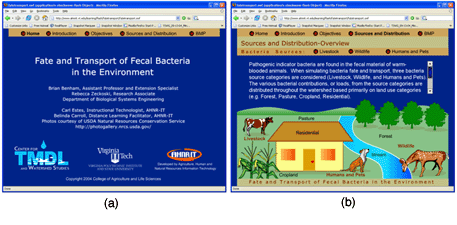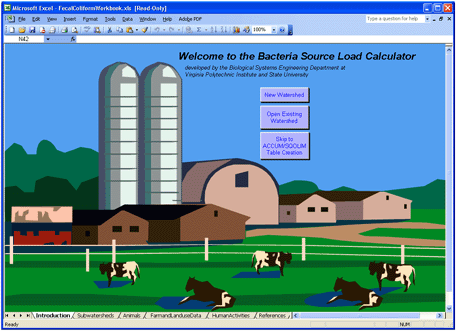December 2006 // Volume 44 // Number 6 // Tools of the Trade // 6TOT7
The Center for TMDL and Watershed Studies: Creating Resources and Tools for Watershed Management
Abstract
The Center for TMDL and Watershed Studies (the Center) is committed to improving the quality and effectiveness of watershed planning processes, including total maximum daily loads (TMDLs). The Center conducts basic and applied research, and provides educational programming tailored to the specific needs of stakeholders, government personnel, and technical professionals. Personnel associated with the Center provide expertise on scientific, engineering, sociological, economic, and policy issues related to watershed management and the TMDL process. The Center is actively involved in developing TMDLs and TMDL implementation plans in situations where the methodology and guidance to develop such deliverables are not well defined.
Introduction
According to the USEPA, over 40% of assessed waters in the U.S. are impaired because of violations of state water quality standards (USEPA, 2004). Under the Clean Water Act (33 U.S.C. ¤¤ 1251-1387), total maximum daily loads (TMDLs) must be developed for impaired waters. Developing TMDLs involves identifying pollutant sources, quantifying their contribution to the impairment, and determining the pollutant reduction required to meet applicable water quality standards.
Across the nation, tens of thousands of TMDLs must be developed in the next 10 to 15 years; public and private costs associated with TMDL development and implementation are estimated to be $15 to $66 billion nationally (USEPA, 2001). The Center for TMDL and Watershed Studies at Virginia Tech (hereafter, the Center) conducts research and outreach to advance watershed management planning tools and techniques used to develop TMDLs.
Much of the Center's applied research is geared to answer questions that arise as part of the Center's TMDL development program. The Center's outreach program is also greatly influenced by our TMDL development experiences. Since 2000, the Center has developed more than three dozen fecal coliform bacteria and aquatic life (benthic) impairment TMDLs. A recently published paper illustrates the Center's TMDL development approach and procedures through a comprehensive case study of two TMDLs (Benham et al., 2005).
Objective
The objective of this article is to review the Center's programs with the hope that others may benefit from our experience, expertise, resources, and tools. The items described here are accessible via the Center's website (Figure 1).
Figure 1.
Center for TMDL and
Watershed Studies Web Site <http://tmdl.bse.vt.edu>

The Center's Outreach Program
As a part of a land-grant university, the Center is committed to outreach, education, and service. The Center has developed outreach programming and resources to serve various clientele, including local stakeholders in a specific watershed, state and federal agency staff, TMDL developers, and Extension and research professionals. Much of the Center's outreach programming deals with education about watershed simulation models.
Complex watershed-scale simulation models are often used to develop TMDLs and TMDL implementation plans. These models simulate pollutant fate and transport in the environment and are used in a "what if" mode to develop pollutant reduction scenarios and TMDL implementation scenarios (various combinations of corrective measures that, when implemented, result in water quality restoration).
Our experience has shown that investing time to educate local stakeholders about these models and the processes they simulate, albeit at a fairly rudimentary level, empowers stakeholders to effectively engage in the TMDL process. Informed stakeholders have more faith in model predictions and feel more ownership of the problem and possible solutions. Water quality ultimately benefits from empowered stakeholders because their questioning of the model can result in better inputs and hence a more accurate TMDL.
To reach local stakeholder clientele, the Center has developed a series of TMDL-related Virginia Cooperative Extension fact sheets that provide basic information about the TMDL process and various tools and procedures used to develop TMDLs (Table 1). The Center has also developed a multimedia Macromedia FlashTM module to educate stakeholders in watersheds where a bacterial impairment exists (Figure 2). After viewing the module, users should be able to describe common sources of fecal coliform bacteria, bacteria fate, and transport mechanisms typically considered when developing a bacteria impairment TMDL, and common best management practices (BMPs) used to control bacterial pollution.
| Fact Sheet Title | Citation |
| A Glossary of Water-Related Terms | Benham, 2002 |
| TMDLs (Total Maximum Daily Loads) –Terms and Definitions | Benham et al., 2002 |
| TMDLs (Total Maximum Daily Loads) for Bacteria Impairments | Benham and Zeckoski, 2005a |
| TMDLs (Total Maximum Daily Loads) for Benthic Impairments | Benham et al., 2003 |
| Microbial Source Tracking and the TMDL (Total Maximum Daily Loads) Process | Hagedorn et al., 2005 |
| Implementation: What happens after the TMDL (Total Maximum Daily Load) is developed? | Benham & Zeckoski, 2005b |
Figure 2.
Multimedia Educational
Module "Fate and Transport of Fecal Bacteria in the Environment," (a)
Opening Screen and (b) Sources and Distribution-Overview Screen

To serve professional clientele, the Center offers continuing education courses that cover a range of topics, including TMDL program basics, the application of various models for TMDL development and implementation planning, and TMDL project management. In the past the Center has offered these courses primarily in conjunction with professional meetings (e.g., the Soil and Water Conservation Society of America and the American Society of Agricultural and Biological Engineers). Future courses will be offered more frequently and be on the campus of Virginia Tech.
In addition to continuing education courses, the Center, through the Department of Biological Systems Engineering at Virginia Tech, offers a graduate course, TMDL Development and Implementation, BSE 5324. This course is typically taught every Fall by a multi-disciplinary team of faculty. The course includes such topics as data sources, data collection, water quality monitoring system design, modeling, project management, and facilitating public participation. Plans are in place to offer this course online to students on and off campus in the Fall of 2006.
Tools and Resources for TMDL Development
In addition to its outreach program, the Center is also engaged in projects to improve watershed management planning tools and techniques used to develop TMDLs. Recently, the Center released the Bacteria Source Load Calculator (BSLC), a software tool to assist in the development of bacteria impairment TMDLs (Zeckoski, et al., 2005). The BSLC is used to generate bacterial loadings from livestock, human, and wildlife sources; these loadings are needed inputs to a watershed-scale water quality models used to develop TMDLs (Figure 3). The BSLC may be downloaded free of charge at the Center's Web site <http://tmdl.bse.vt.edu>.
Figure 3.
Bacteria Source Load
Calculator opening screen (Zeckoski et al., 2005)

Constraints of time and resources, rapid advances in related science and engineering disciplines, and information overload often make it difficult to find the most current and relevant TMDL information available. To address this issue, the Center has partnered with United States EPA to develop a Web-based TMDL information knowledgebase. The EPA TMDL Clearinghouse will be a repository for information and resources related to the successful development and implementation of TMDLs and watershed management plans. The core of the clearinghouse will be a searchable database. The clearinghouse will also feature a National TMDL Resource Directory that will facilitate easy access to educational, technical, and governmental organizations and their resources.
Summary
The Center for TMDL and Watershed Studies conducts research to advance watershed management planning tools and techniques used to develop TMDLs and outreach to educate others about these advances. The Center publishes a quarterly newsletter to update readers about its resources and activities available at <http://tmdl.bse.vt.edu>.
References
Benham, B. L., Brannan, K. M., Yagow, G. R. Zeckoski, R. W., Dillaha, T. A., Mostaghimi, S., & Wynn, J. W.. (2005). Development of bacteria and benthic TMDLs: a case study, Linville Creek, Virginia. J. Environ. Qual. 34:1860–1872.
Benham, B. L., & Zeckoski. S. (2005a). TMDLs (Total Maximum Daily Loads) for bacteria impairments. Virginia Cooperative Extension. 6 pp. Available at: http://www.ext.vt.edu/pubs/bse/442-555/442-555.pdf
Benham, B. L., & Zeckoski. S. (2005b). Implementation: What happens after the TMDL is developed? Virginia Cooperative Extension. Available at: http://www.ext.vt.edu/pubs/bse/442-559/442-559.pdf
Benham, B. L., Walker, J. L., & Yagow, G. (2003). TMDLs (Total Maximum Daily Loads) for benthic impairments. Virginia Cooperative Extension. 4 pp. Available at: http://www.ext.vt.edu/pubs/bse/442-556/442-556.pdf
Benham, B. L., Brannan, J. L., Dillaha, T. Mostaghimi, S., & Yagow, G. (2002). TMDLs (Total Maximum Daily Loads)--terms and definitions. Virginia Cooperative Extension. 8 pp. Available at: http://www.ext.vt.edu/pubs/bse/442-550/442-550.pdf
Benham, B. L. (2002). A glossary of water-related terms. Virginia Cooperative Extension. 8 pp. Available at: http://www.ext.vt.edu/pubs/bse/442-758/442-758.pdf
Hagedorn, C., Benham, B. L., & Zeckoski, S. (2005). Microbial source tracking and the TMDL process. Virginia Cooperative Extension. 4 pp. Available at: http://www.ext.vt.edu/pubs/bse/442-554/442-554.pdf
USEPA (2004). Overview of current Total Maximum Daily Load–TMDL–program and regulations. U.S. Environmental Protection Agency, Washington, DC, [Online]. Available at: http://www.epa.gov/owow/tmdl/overviewfs.html
USEPA. (2001). The national costs of the Total Maximum Daily Load program. EPA 841-D-01-003. U.S. Environmental Protection Agency, Washington, DC. [Online], Available at: http://www.epa.gov/owow/tmdl/coststudy/coststudy.pdf
Zeckoski, R. W., Benham, B. L., Shah, S. B., Wolfe, M. L., Brannan, K. M., Al-Smadi, M., Dillaha, T. A., Mostaghimi, S., & Heatwole. C. D. (2005). BSLC: A tool for bacteria source characterization for watershed management. Appl. Eng. Agricul. Vol. 21(5): 879-889
